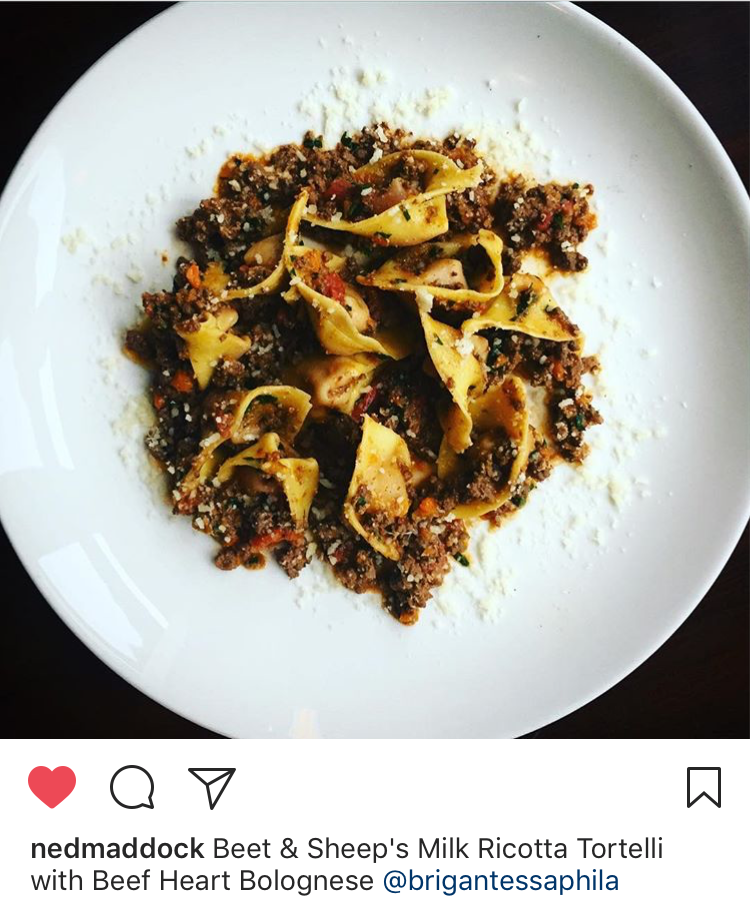It was nearly two decades ago that I reconciled my own feelings about taking lives for food and committed to becoming a whole animal eater. In an effort to honor the animals we eat, I vowed to never lose the connection of the cuts and parts to the whole, and never to waste what was sacrificed to feed us.
In the years that followed, I bravely abandoned my first career and set out to become a whole animal butcher. In pursuit of the craft, and later efforts to build up a local supply chain as a purveyor, my goal was always to educate and serve more eaters like me while supporting small family farms in the process. And while my intentions have never wavered, since closing my meat business, I’ve suffered a crisis of conscience.
When I finally had the capacity to reflect on how others view me as a butcher, I began to worry that my mission was lost in the execution. How had I become the “meat lady”, an unintentional ambassador for carnivorous diets and assumed friend to all meat eaters, when it was the need for greater ethical awareness around eating animals that drew me to pursue butchery in the first place?
I don’t have an answer to offer, only this preface before sharing a story about my life in meat.
The business of butchery has always fascinated me. I’m not talking about the cutting and merchandising of pretty steaks in a display case—although the designer in me took a liking to that part of the craft. What I’m referring to is the complexity of making all of the parts of the animal enticing, or at least salable, while minimizing waste in order to sustain a profit. As I advanced through my time as an apprentice, first on a regenerative livestock farm, then in a whole animal butcher shop, I never stopped puzzling over how to solve the recurring issues which almost always revolved around what happens to the less desirable bits.
My graduation from apprentice to butcher at The Local Butcher Shop in Berkley, CA happened to coincide with a trending belief that one could improve their health with the inclusion of more iron-rich organ meats (a true fact, and this trend, along with increased interest in the nutritional benefits of bone broth, was a boon for us butchers). As a friendly face at the ethical, whole-animal butcher shop in town, I was an obvious resource for customers to pose their inquiries about how they might achieve this culinarily.
Eager to advise home cooks with my new-found skills and knowledge, I became an advocate for beef heart.
Knowledge of not just anatomy, but also consideration of what action took place in the life of an animal, can tell you how to cook a cut. The muscles that don’t get used heavily, like the tenderloin that everyone covets, which rides lazily on the back of four-legged animals, remain tender. In more hard working muscles, connective tissue and other sinew build up through continuous activity, all of which will take a patient cook time to slowly break down into a texture that is palatable and not “chewy”. However, the reward for this effort is rich flavor. Think about the taste of lamb shanks or pork shoulder.
Based on this understanding, there are two obvious approaches to cooking heart. As a very active muscle that does all that work of contracting and beating continuously to keep us alive, you can cook it for a long time or barely cook it at all. Somewhere in the middle the meat will just become tough. My recommendation was and still is that you should steel yourself to try eating heart raw.
By the time I stepped behind the butcher counter, I had already been initiated to eating beef heart. One of the ways I’d tasted it was the classic Latin American preparation of anticuchos, in which beef heart is marinated, skewered to grill hot and fast, and eaten at a charred medium-rare. This is a great dish, but personally, the heavily acidic, vinegar-based marinade (which assists in breaking down the would-be-tough muscle fibers in the process), does not result in a taste or texture that I love. I much prefer the purity of a beef heart tartare.
For tartare, you trim the heart of all its external fat, internal ventricles, and bits of visible sinew, leaving you with flat pieces of lean yet muscular heart wall. I like to cut tartare by hand, methodically turning it into strips, cross-cutting those into a moderately small dice, and then collecting the pile of meat on the cutting board to repeatedly move my knife through until it is minced into fine bits. The simplest preparation would be to toss the meat with some nice sea salt, a bit of olive oil, a grind of black pepper, and a squeeze of lemon. Scooping this concoction into your mouth with a potato chip is a bite of bliss.
You could of course get more elaborate or traditional with your tartare, including classic ingredients like minced shallots, pickles or cornichons, and capers, all folded in along with dijon mustard. If you desire an egg yolk, which some recipes call to also fold in, I must note that I favor the composition of creating an indentation in the center of the tartare to hold the in-tact yolk. This allows you to break and distribute egg into the meat at will.
I learned through unfortunate trial and error that suggesting one find their entrée into organ eating via a dish of raw beef heart was a bit too intimidating. Eventually, I changed tack to recommend ground meat including heart, which was much more approachable, and not that different from the grind of beef trim and organ meats that I was already making for the well-fed pets of the East Bay. Obviously, that was not necessarily a selling point.
Inspiration for this custom grind was likely flavored by my growing love for hanger steak. This was my butcher’s cut, although not because it was cheap and undesirable (that’s a thing of the past), but because as the butcher you could reserve the one coveted hanger steak per animal for yourself. The taste of hanger steak is best described as irony and rich from its contact with blood and other organs, since it “hangs” about in the diaphragm during the life of the animal. It occurred to me that heart, if cut with some standard 80/20 beef trim in the process of grinding, would lessen the assault of iron on your tongue and might produce a burger that tastes as if I had put that precious “Onglet” through the grinder. Which, by the way, I would never dare.
My motivation for enthusiastically hustling beef and heart grind also came from a place of kindness towards the unknowing organ eaters of Berkley, after a customer who was determined to feed his children more liver for iron consumption asked that I grind the portion I had cut for him. I protested his request, warning that a grind of straight liver would produce a soft and liquidy mush. That wasn’t going to stop him. He handed me a sippy cup belonging to his toddler and told me I could grind the liver straight into it.
Having suggesting my beef heart blend idea to a few customers who were happy for a more palatable organ meat recipe from the local butcher to make a nutrient-rich burger, I realized I should practice what I was preaching and selling. At home I began to make not only burgers, but also meatballs with my 50/50 grind of beef and beef heart, delighting in the subtle intensity of the results.
Years later, as the proprietor of my own whole-animal butchery in Philadelphia, this would become one of our regular and frequently requested offerings. Throughout its operation, Primal Supply Meat’s beef heart grind was always on the production list, limited only by the number of whole beef we harvested each week, as there is only one heart, weighing in somewhere between 3-5 lb., in each of the 800 lb. beasts (and the single hanger steak yields even less than that).
Eventually, it was not all that much more sustainable to promote demand for beef heart than it is to suggest that everyone cook hanger steak, and certainly don’t expect it as a stand-by on that neighborhood bistro menu. But viewing this experience through the whole-animal/zero-waste lens of my mission as a butcher, creating demand and enthusiasm1 around a frequently cast-off organ felt like a success.

Recommended Reading & Eating
Food Costs and The Election
“The Deep Dish”, a newsletter from Civil Eats, offers an insider look at food and farming. As the election approaches, the latest issue connects politics to the kitchen table, asking “Can Lawmakers Really Tackle High Food Costs?” (read link)
Few other goods and services are as omnipresent as food purchases, and food prices are often where everyday Americans feel economic shifts most immediately.
Corporate consolidation is undoubtedly one of the sources not only of high food costs, but also the continuation of unsustainable practices and pollution in all parts of our food supply chains. Elevating this conversation to the policy level is grounds for hope.
Seasonal Eating is Sustainable Eating
recently explored in the Washington Post how agricultural diversity is crucial to fighting climate change, but it requires consumer participation....it’s easier to go to the supermarket, rely on the same types of vegetables and fruits that one knows how to use, and pick up meat from the case. That is, after all, the basis of the U.S. food system. It’s built to be reliable, uniform and abundant, with strawberries, apples and tomatoes regardless of the season outside.
A constant challenge small, local farmers face is educating and inspiring customers to cook and eat new things. It’s time to explore diversity in the kitchen and increase our collective awareness of seasonality. As Kennedy says, “Want to eat sustainably? Learn to cook something new.” (read link)
Forget The Parts, Eat Whole Chicken
If you’re thinking about how you might continue to consume meat with whole-animal awareness, I recommend whole chicken. Your local farmer or butcher will thank you for not just buying up all the chicken breasts and leaving them to deal with the rest.
Personally, I love a simple roast chicken, which in my 2 person household easily stretches into multiple meals by reinventing the leftovers. But on the cusp of fall, my appetite is quickly turning to crave cozy foods. For a warming, one-pot dish to feed a household (which makes excellent as-is leftovers), I adore Melissa Clark’s “Sesame Braised Chicken With Scallions, Daikon and Mushrooms”, a recipe I’ve been riffing on for over a decade now. I’d also encourage you to give Nigella Lawson’s “Chicken in a Pot with Lemon Orzo” a go. There is a reason it’s one of the most searched and shared recipes on the internet.
And as a parting note, keep in mind, you can always substitute the ingredients like daikon radishes in the above recipes with other seasonal vegetables. Ask your local farmer at the market, and I bet they’d love to offer a recommendation.
As always, thanks for reading and just being here.
XX,
Heather
I’ll always be proud when beef heart tartare and other offal-driven dishes pop up on menus at Philly restaurants helmed by chefs who are hip to sourcing and seasonality, and at one time were supplied by my company.





Oh wow. Ari Miller did a marvelous beef heart tartare at MUSI back in the day.